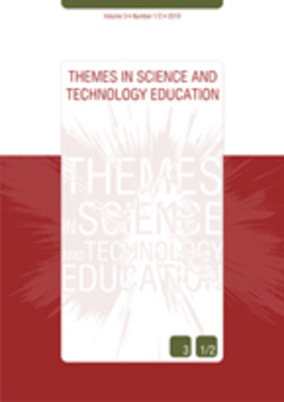Learning to explain : The role of educational robots in science education
Part of : Themes in science and technology education ; Vol.6, No.1, 2013, pages 29-38
Issue:
Pages:
29-38
Abstract:
Educational robotics laboratories typically involve building and programming robotic systems to perform particular tasks or solve problems. In this paper we explore the potential educational value of a form of robot-supported educational activity that has been little discussed in the literature. During these activities, primary school children are asked to explain the behaviors of a robot constructed in advance by the teacher or laboratory supervisor, rather than having to construct or program a robot themselves. It is argued that activities of this kind may have a significant role to play within science education: participation in a collaborative process aimed at explaining the behaviors of an educational robot provides children with the opportunity to develop scientific research skills and competencies and to engage in meta-cognitive reflection on fundamental issues surrounding scientific research methods.
Subject:
Subject (LC):
Keywords:
educational robotics, robotics in science education, philosophy of science
References (1):
- Braitenberg, V. (1986). Vehicles. Experiments in Synthetic Psychology. Cambridge, MA: The MIT Press.Bredenfeld, A., Hofmann, A., & Steinbauer, G. (2010). Robotics in education initiatives in Europe: Status, shortcomings and open questions. In E. Menegatti (ed.), Proceedings of SIMPAR 2010 Workshop, International Conference on Simulation, Modeling and Programming for Autonomous Robots (pp. 568-574). Darmstadt, Germany.Brockman, J. (ed.) (2004). Curious mind. How a child becomes a scientist. New York: Pantheon.Brooks, R. A. (1986). A robust layered control system for a mobile robot. IEEE Journal of Robotics and Automation, 2(1), 14-23.Catlin, D., & Balmires, M. (2010). The e-Robot project: A longitudinal on-line research collaboration to investigate ERA principles. In E. Menegatti (ed.), Proceedings of SIMPAR 2010 Workshop, International Conference on Simulation, Modeling and Programming for Autonomous Robots (pp. 411-420). Darmstadt, Germany.Cincelli, S., Festi, G., Finotti, F., Lenzen, D., & Monfalcon, S. (2010). Teaching with robotics: different experiences at school after the TERECoP courses. In E. Menegatti (ed.), Proceedings of SIMPAR 2010 Workshop, InternationalConference on Simulation, Modeling and Programming for Autonomous Robots (pp. 429-438). Darmstadt, Germany. Craver, C. F. (2007). Explaining the brain: Mechanisms and the mosaic unity of neuroscience. Oxford University Press.Datteri, E. (2010). Simulazioni, spiegazioni e generalizzazioni nelle scienze cognitive [Simulations, explanations and generalizations in the cognitive sciences]. Sistemi Intelligenti, 3, 459-466.Datteri, E., & Laudisa, F. (2010). Simulazione e spiegazione: il ruolo delle leggi nei modelli neuroscientifici [Simulation and explanation: the role of laws in neuroscientific models]. Sistemi Intelligenti, 12(1), 98-118.Denis, B. (2001). Collaborative learning in an educational robotics environment. Computers in Human Behavior, 17(5-6), 465-480.Goldman, R., Pea, R., Barron, B., & Derry, S. (eds.) (2007). Video research in the learning sciences. New York: Routledge.Kelly, G. A. (1955). The psychology of personal constructs. New York: Norton.Ladyman, J. (2002). Understanding philosophy of science. New York: Routledge.Mioduser, D., Levy, S.T., & Talis, V. (2007). Episodes to scripts to rules: concrete-abstractions in kindergarten children’s explanations of a robot’s behaviour. International Journal of Technology and Design Education, 19(1),15-36.Nagel, E. (1961). The structure of science. New York: Harcourt, Brace & World Inc.Nigris, E. (2009). Le domande che aiutano a capire [The questions which help children understand]. Milano: Bruno Mondadori.Norton, S. J., McRobbie, C. J., & Ginns, I. S. (2006). Problem solving in a middle school robotics design classroom. Research in Science Education, 37(3), 261-277.Psillos, S. (2002). Causation and explanation. Acumen - McGill Queens University Press.Simon, H. A. (1969). The sciences of the artificial. Cambridge, MA: The MIT Press.Sullivan, F. R. (2008). Robotics and science literacy: Thinking skills, science process skills and systems understanding. Journal of Research in Science Teaching, 45(3), 373-394.van Fraassen, B. C. (1980). The scientific image. Oxford: Clarendon Press. Walter, W. G. (1950). An imitation of life. Scientific American, 182(5), 42–45.




